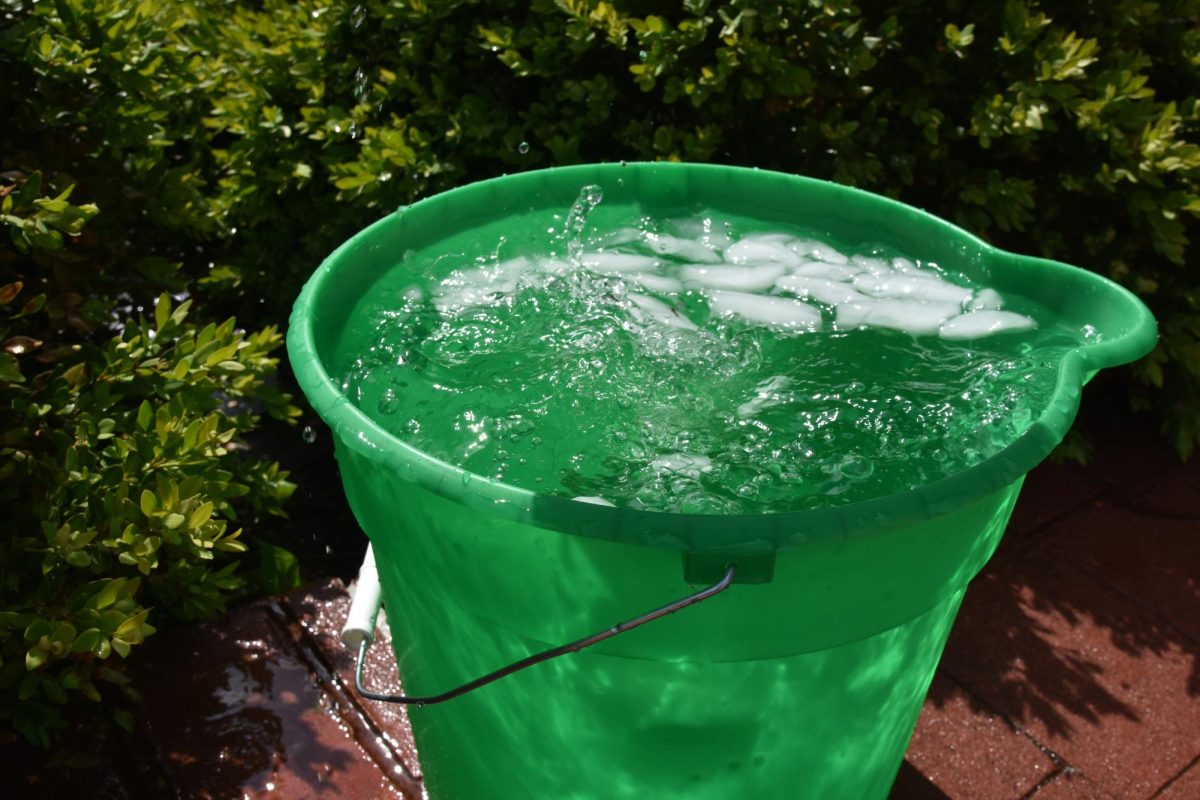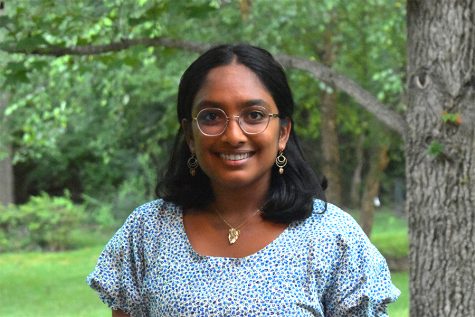In the cafeteria during fifth hour Jan. 6, Principal Dr. Mitchell taught three classes simultaneously. Academic Support teachers left their classrooms to deliver lessons, substitutes rushed from class to class during passing period and teachers sacrificed plan time to cover for colleagues.
The data is red. Pandemic markers are all at record highs, not even counting for the cases confirmed through the new at-home tests. Death rates, however, largely remain the same. As such, despite facing staffing shortages and student absences, school remains open in-person for now.
“The goal of our school district, and the goal of this school, will be to have students here. There are days in which we don’t have enough substitutes to cover the teachers. It’s not ideal, but we feel like still having experiences with the majority of your teachers and having one or two [classes] in this situation [without a substitute], especially now when we’re doing a lot of review finals and it’s not new material, is not the best, but it’s better than than the other options,” Mitchell said.
One way school is able to remain open despite teacher absences and substitute shortages is other staff stepping in to deliver lesson plans.
“If I’m subbing I’m not able to help anybody else during that time.You’re not going to actually be able to do your own job if you’re in another classroom; it’s stressful on my end because I can’t help the kids that I would normally help,” English Academic Support Center interventionist Kristen Witt said. “I do a lot of one on one work [with students] as far as how to write papers and make sure that their editing skills are on it and they’re understanding the stories they’re reading for class. It’s causing everybody stress because students are unable to get the help that they need.”
According to the Centers for Disease Control and Prevention (CDC), schools should take every possible measure to support in-person learning because it protects equitable access to health and education.
“I don’t see a complete solution until COVID-19 goes away, but [it’s] not just going to go away overnight. We just have to ride it out and hope for the best,” Witt said. “Teachers are doing everything they can to make sure that school is still here for the kids, still up and running and functioning. It’s really a community effort on that front.”
At the Board of Education Special Meeting Jan. 7, members carried a motion “to maintain the District’s current pandemic response plan related to students until such time as the Administration can review data related to student illness and health and safety recommendations, to be reviewed and considered by the Board of Education no later than its regular meeting on January 19, 2022.” In the meantime, staff are trying to hang on.
“We’re trying to do as best we can. The elementary thing is the handwashing. And obviously, we still enforce the masks. We’re trying to provide an environment as safe as possible. Let’s be honest, you’re at lunchtime, you’re not going to be wearing your mask, but you’re going to be three feet [apart]. [If] you go to a sporting event, we do the same thing. We’re not going to put everybody in a bubble, but you are required to do some things to try to make sure that everybody’s safe,” Mitchell said.
While Parkway is upholding these measures, teacher absences are changing the content students are learning and final exams.
“My Chemistry teacher is quarantined because she has COVID-19. This whole week, we aren’t going to be able to really prepare with her and understand what’s going to be on the final with the worksheets and lessons she had planned,” senior Caroline Bergh said. “Instead, we’ve just been doing a packet. The packet isn’t the most fun thing to do, it’s really not, but I think she understands that. If she were here, we’d probably be learning a little more and we’d have a normal final but we can’t do that right now, so we’re just going to have to really make it work.”
The school continues fighting to keep classrooms open, relying on cooperation from staff and students alike.
“The safer you are at home, the safer we can be here. I’m not going to tell you what’s safe. I’m not telling people what to do, how to act or how to live their lives. But while we’re here, we’re just trying to do things that are safe and keep students safe,” Mitchell said. “It’s been kind of a crazy week back but when we had three classes in here, the kids were great. They understand.”


![Spending their seventh hour in the cafeteria Jan. 6, juniors Matthew Feng, Sangarshan Kumar, Michael Feng, Govind Menon, Om Shinde, Samarth Samal and Bennett Christofferson join a Zoom with their teacher to get help with their assigned work. Their teacher assigned a packet with lecture notes, guided problems and self-check problems and opened a Zoom room during class hours to ensure students were supported. “For some people, school is the only place they feel safe. On the other hand, we’re also in the biggest COVID-19 spike [of cases] right now. Both sides have ups and downs,” Samal said. “I personally am fine with staying in school as long as it doesn't interfere with my learning too much because I'm vaccinated and I wear my mask properly. If I can cover the content by myself with my teacher available on Zoom, I'm flexible with any option.”](https://pwestpathfinder.com/wp-content/uploads/2022/01/Sub-Shortage-Red-900x600.jpg)

![Smiling in a sea of Longhorns, Fox 2 reporter Ty Hawkins joins junior Darren Young during the morning Oct. 3 pep rally. The last time West was featured in this segment was 2011. “[I hope people see this and think] if you come to [Parkway] West, you will have the time of your life because there are so many fun activities to do that make it feel like you belong here. I was surprised so many people attended, but it was a lot of fun,” Young said.](https://pwestpathfinder.com/wp-content/uploads/2025/10/Edited2-1200x798.jpg)
![West High seniors and families listen as a representative of The Scholarship Foundation of St. Louis, Teresa Steinkamp, leads a Free Application for Federal Student Aid (FAFSA) workshop. This session, held in the library, provided guidance on financial aid, scholarships and student loan options. “This event is very beneficial for any seniors who are applying to or considering applying to colleges after high school [because] the cost of college is on the rise for seniors and parents,” college and career counselor Chris Lorenz said.](https://pwestpathfinder.com/wp-content/uploads/2025/09/DSC_4478-1200x778.jpg)
![Senior Kamori Berry walks across the field during halftime at the Homecoming football game on Sept. 12. During the pep assembly earlier that day, she was pronounced Homecoming Queen. “I thought it was nice that the crowd [started] cheering right away. I know [my friends] were really excited for me, and my family was happy because typically non-white people don't win,” Berry said.](https://pwestpathfinder.com/wp-content/uploads/2025/09/DSC7046-Enhanced-NR-1200x798.jpg)



![Pitching the ball on Apr. 14, senior Henry Wild and his team play against Belleville East. Wild was named scholar athlete of the year by St. Louis Post-Dispatch after maintaining a high cumulative GPA and staying involved with athletics for all of high school. “It’s an amazing honor. I feel very blessed to have the opportunity to represent my school [and] what [it] stands for,” Wild said.](https://pwestpathfinder.com/wp-content/uploads/2025/05/unnamed-6-1200x714.jpg)
![The Glory of Missouri award recipients stand with their certificates after finding out which virtue they were chosen to represent. When discovering their virtues, some recipients were met with contented confirmation, while others, complete surprise. “I was not at all surprised to get Truth. I discussed that with some of the other people who were getting the awards as well, and that came up as something I might get. Being in journalism, [Fellowship of Christian Athletes and] Speech and Debate, there's a culture of really caring about truth as a principle that I've tried to contribute to as well. I was very glad; [Truth] was a great one to get,” senior Will Gonsior said.](https://pwestpathfinder.com/wp-content/uploads/2025/04/Group-Glory-of-Missouri.jpg)

![Senior Dhiya Prasanna examines a bottle of Tylenol. Prasanna has observed data in science labs and in real life. “[I] advise the public not to just look or search for information that supports your argument, but search for information that doesn't support it,” Prasanna said.](https://pwestpathfinder.com/wp-content/uploads/2025/10/DSC_0073-2-1200x800.jpg)
![Sophomore Aleix Pi de Cabanyes Navarro (left) finishes up a soccer game while junior Ava Muench (right) warms up for cross country practice. The two came to Parkway West High School as exchange students for the 2025-2026 school year. “The goal for the [exchange] program is to provide opportunities for both Parkway students and our international exchange students to learn about other cultures, build connections and become confident, capable, curious and caring — Parkway’s Four C’s — in the process,” Exchange Program Lead Lauren Farrelly said.](https://pwestpathfinder.com/wp-content/uploads/2025/10/Feature-Photo-1200x800.png)
![Leaning on the podium, superintendent Melissa Schneider speaks to Parkway journalism students during a press conference. Schneider joined Parkway in July after working in the Thompson School District in Colorado. “My plan [to bond with students] is to get things on my calendar as much as possible. For example, being in [classes] is very special to me. I am trying to be opportunistic [meeting] kids [and] being in [the school] buildings. I have all the sports schedules and the fine arts schedules on my calendar, so that when I'm available, I can get to them,” Schneider said.](https://pwestpathfinder.com/wp-content/uploads/2025/09/IMG_5425-1200x943.jpeg)
![Gazing across the stage, sophomore Alexis Monteleone performs in the school theater. The Monteleone family’s band “Monte and the Machine” has been releasing music since 2012, but Alexis started her own solo career in 2024 with the release of her first single, Crying Skies. “My whole family is very musical, [and I especially] love writing [songs with them],” Monteleone said.](https://pwestpathfinder.com/wp-content/uploads/2025/09/DSC7463-1200x798.jpg)
![Leaping through the air, senior Tyler Watts celebrates his first goal of the season, which put the Longhorns up 1-0 against the Lafayette Lancers. Watts decided to play soccer for West for his last year of high school and secured a spot on the varsity roster. “[Playing soccer for West] is something I had always dreamed of, but hadn’t really had a good opportunity to do until now. It’s [really] fun being out [on the field], and I’m glad I decided to join the team. It’s just all about having fun with the boys and enjoying what time we have left together,” Watts said.](https://pwestpathfinder.com/wp-content/uploads/2025/09/DSC_1951-1200x855.jpg)

![Junior Fiona Dye lifts weights in Strength and Conditioning. Now that the Trump administration has instituted policies such as AI deregulation, tariffs and university funding freezes, women may have to work twice as hard to get half as far. "[Trump] wants America to be more divided; he wants to inspire hatred in people,” feminist club member and junior Clara Lazarini said.](https://pwestpathfinder.com/wp-content/uploads/2025/05/Flag.png)
![As the Trump administration cracks down on immigration, it scapegoats many immigrants for the United States’ plights, precipitating a possible genocide. Sophomore Annabella Whiteley moved from the United Kingdom when she was eight. “It’s pretty scary because I’m on a visa. When my visa expires next year, I’m not sure what’s going to happen, especially with [immigration] policies up in the air, so it is a concern for my family,” Whiteley said.](https://pwestpathfinder.com/wp-content/uploads/2025/05/DSC_0077-7copy.jpg)
![Shifting global trade, President Donald Trump’s tariffs are raising concerns about economic stability for the U.S. and other countries alike. “[The tariffs are] going to pose a distinct challenge to the U.S. economy and a challenge to the global economy on the whole because it's going to greatly upset who trades with who and where resources and products are going to come from,” social studies teacher Melvin Trotier said.](https://pwestpathfinder.com/wp-content/uploads/2025/05/MDB_3456-1200x800.jpg)
![Red, white and blue, the American flag holds the values of our democracy. The fight that we once endured has returned, as student journalists and senior correspondents across the country are losing their voices due to government control. “[Are] the White House and [the] government limiting free speech [and] freedom of the press? Yes [they are],” chief communications officer of the Parkway School District and former journalist Elisa Tomich said.](https://pwestpathfinder.com/wp-content/uploads/2025/03/Untitled-design-14.jpg)
